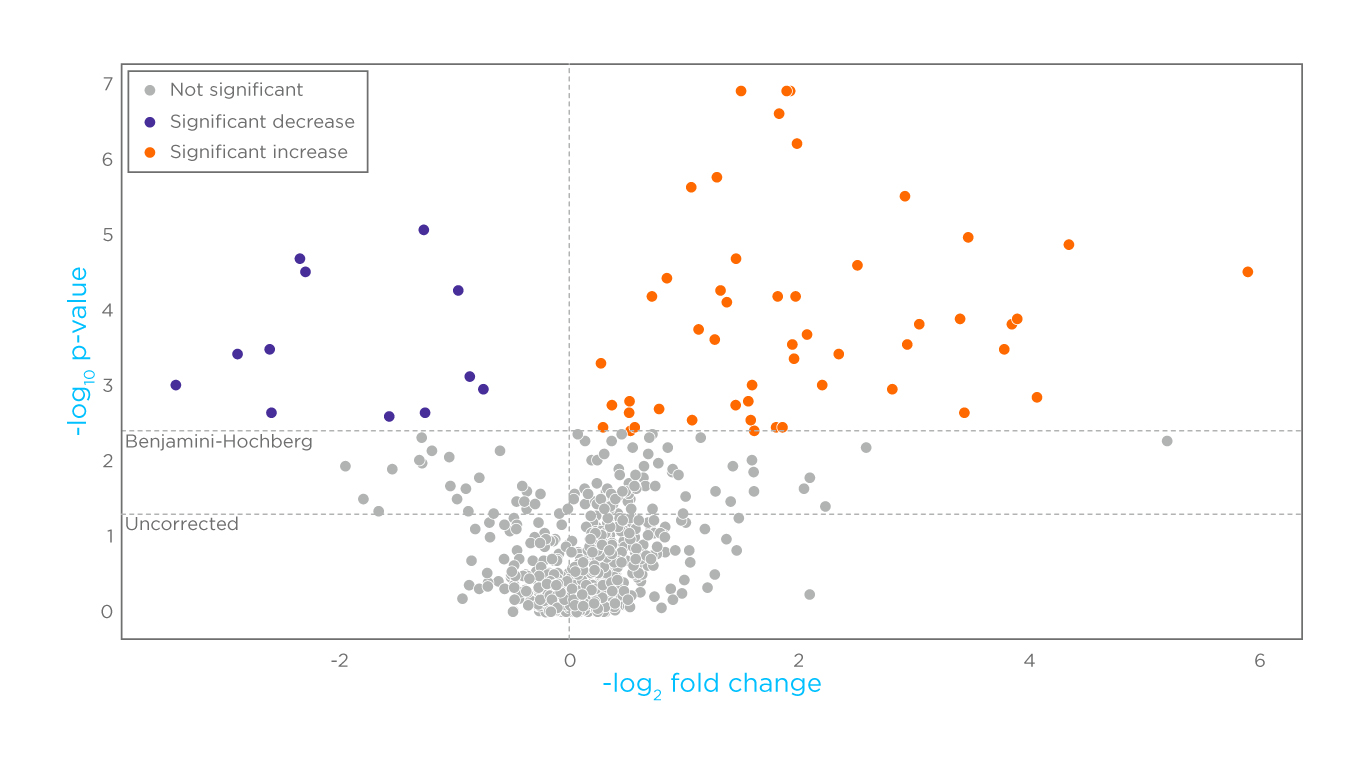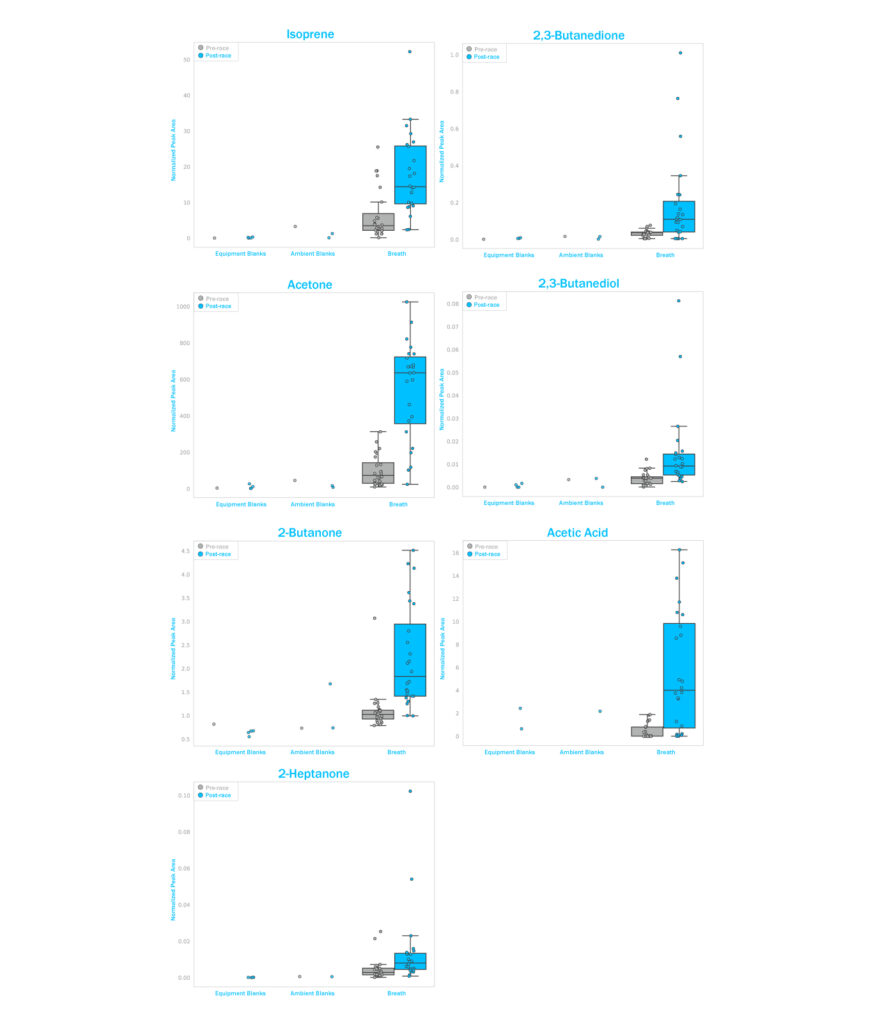VOCs reflect physiological changes in ultramarathon runners
VOCs significantly changed post-race are associated with physiological changes in exhaustive exercise.
| Publication information: Hsuan Chou et al. Metabolic insights at the finish line: deciphering physiological changes in ultramarathon runners through breath VOC analysis. Journal of Breath Research (2024). DOI 10.1088/1752-7163/ad23f5
Application: Evaluate VOCs in exhaled breath that differ in abundance between matched pairs of samples collected before and after the Ultra-Trail du Mont Blanc (UTMB) ultra-marathon, to identify potential breath biomarkers of exhaustive exercise. Sample medium: Breath Analysis approach: TD-GC-MS Summary:
|
Although moderate exercise has been shown to have many positive impacts on human health, increasing the duration and intensity of this exercise beyond a reasonable level in exhaustive exercise may result in negative physiological impacts on the human body (1). Studies have previously demonstrated that running extensive distances can result in cardiovascular dysfunction, increased susceptibility to respiratory tract infections, severe inflammation, and muscle damage (2–5). It is reasonable to hypothesize that lung injury at the alveolar-capillary membrane may be a contributing factor to some of these negative physiological impacts, given the increased susceptibility to lung inflammation and infection resulting from exhaustive exercise.
Lung injury, alongside other negative impacts of exhaustive exercise, can be studied by analyzing VOC metabolites in exhaled breath. These VOCs may represent physiological processes both immediate to the respiratory tract and those deeper within the body as a result of their ability to diffuse into the bloodstream in all areas of the body and hence exchange into the breath as blood travels through the lungs. This ability to study metabolic changes proximal and distal to the lungs makes VOC analysis in exhaled breath a valuable tool for studying exhaustive exercise.
Previously, there has been little research into the potential of VOCs as markers for exhaustive exercise. Our new study in collaboration with the Mayo clinic published in the Journal of Breath Research by Chou et al. aimed to evaluate VOCs in exhaled breath that differ in abundance between matched pairs of samples collected before and after an ultra-marathon using Breath Biopsy technology. The main goal was to identify potential biomarkers of exhaustive exercise and therefore gain a better understanding of the physiological changes that occur during exhaustive exercise.
Production and analysis of the VOC dataset
Samples for the study were collected from volunteers before and after they had participated in the 2019 Ultra-Trail du Mont-Blanc ultra-marathon. VOCs from the breath of these volunteers were collected using the RECIVA breath sampler developed by Owlstone Medical and were analyzed using the Breath Biopsy Platform with GC-Orbitrap™ through thermal desorption gas chromatography-mass spectrometry. The final dataset included 24 matched sample pairs for analysis.
Across all samples, 811 different VOC signals were identified, 74 of which were assigned compound identities using the Breath Biopsy HRAM Library. Correction for multiple testing identified 63 features with significant differences in pre- and post-race samples, 51 of these features increased in post-race samples, as demonstrated in figure 1. Of these features, 10 had identities assigned from the Breath Biopsy Library.
Figure 1. Volcano plot of high-level VOC changes between pre- and post-race samples. A total of 63 VOCs reached statistical significance (Benjamini– Hochberg adjusted p < 0.05) between pre- and post-race samples (12 decreased shown in purple and 51 increased shown in orange).
Specific VOCs reflecting physiological changes in exhaustive exercise
VOCs identified as reflecting physiological changes in exhaustive exercise were in the chemical classes of ketones, alcohols, alkenes, carboxylic acids, siloxanes, carboxylic esters, and diazoles. Seven of these compounds were seen to significantly increase in post-running samples, including acetone, isoprene, and 2-butanone, as demonstrated in figure 2 below.
Figure 2. VOCs significantly changed post-race that are associated with physiological changes in exhaustive exercise.
Physiological changes reflected by VOCs increased in ultramarathon runners breath post-race samples
The identities of the increasing VOCs that showed increases in the post-race samples suggest processes such as fatty acid oxidation, inflammation, and possible altered gut microbiome may be involved in the body’s response to exhaustive exercise. For instance, acetic acid showed the greatest fold change increase in the breath samples after the marathon, and can imply alternative energy sources or changes to microbial activity of the gut microbiome.
The compounds 2-butanone and 4-heptanone, products of dietary lipid oxidation and conversion from aldehydes, may be reflective of the use of lipids as an alternative energy source during exhaustive exercise (6). This could potentially reflect inflammation occurring at or near the alveolar-capillary membrane due to lung injury, or inflammation elsewhere in the body. The presence of 2,3-butanedione and 2,3-butanediol in post-race samples supports the effects of exhaustive exercise on the gut microbiome, both compounds being by-products of microbial fermentation.
The identified differences in VOC content of exhaled breath in pre-race and post-race samples of ultramarathon runners have provided insights into physiological changes occurring in response to exercise. These findings suggest that the use of Breath Biopsy technology to measure exhaled biomarkers has great potential to help athletes monitor their health, particularly in comparison to more invasive methods such as blood sampling.
References:
- Shi M, Dong Z, Zhao K, He X, Sun Y, Ren J, et al. Novel insights into exhaustive exercise-induced myocardial injury: Focusing on mitochondrial quality control. Front Cardiovasc Med. 2022 Oct 14;9:1015639.
- Webner D, DuPrey KM, Drezner JA, Cronholm P, Roberts WO. Sudden cardiac arrest and death in United States marathons. Med Sci Sports Exerc. 2012 Oct;44(10):1843–5.
- Robson-Ansley P, Howatson G, Tallent J, Mitcheson K, Walshe I, Toms C, et al. Prevalence of allergy and upper respiratory tract symptoms in runners of the London marathon. Med Sci Sports Exerc. 2012 Jun;44(6):999–1004.
- Howatson G, McHugh MP, Hill JA, Brouner J, Jewell AP, van Someren KA, et al. Influence of tart cherry juice on indices of recovery following marathon running. Scand J Med Sci Sports. 2010 Dec;20(6):843–52.
- Bonasia DE, Rosso F, Cottino U, Rossi R. Exercise-induced leg pain. Asia-Pac J Sports Med Arthrosc Rehabil Technol. 2015 May 2;2(3):73–84.
- Grebenteuch S, Kanzler C, Klaußnitzer S, Kroh LW, Rohn S. The Formation of Methyl Ketones during Lipid Oxidation at Elevated Temperatures. Molecules. 2021 Feb 19;26(4):1104.

